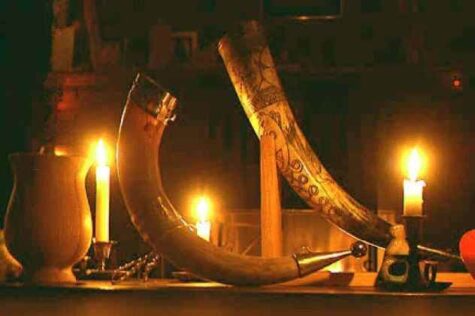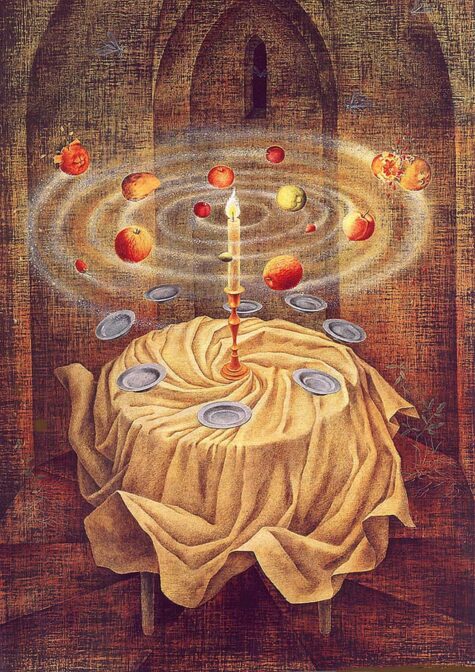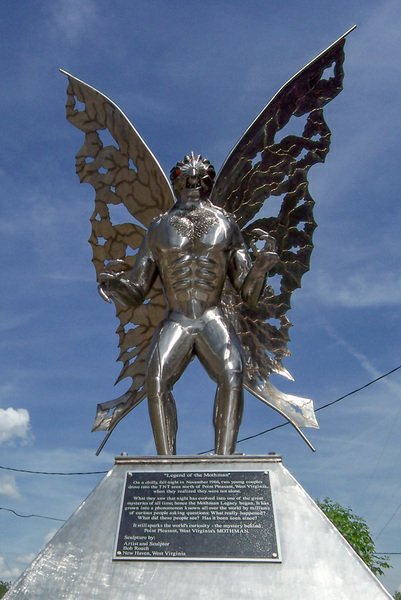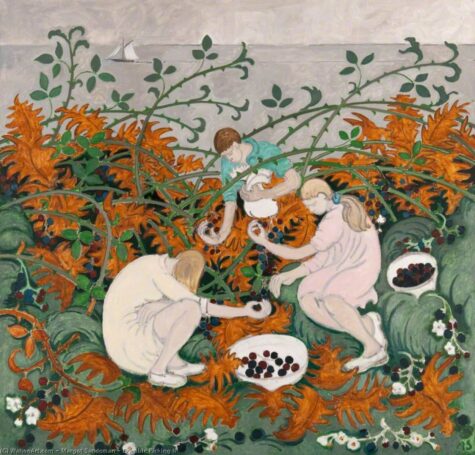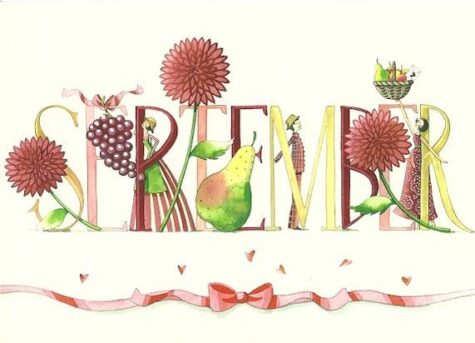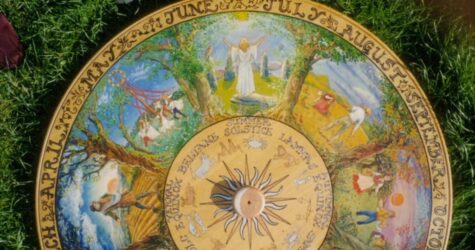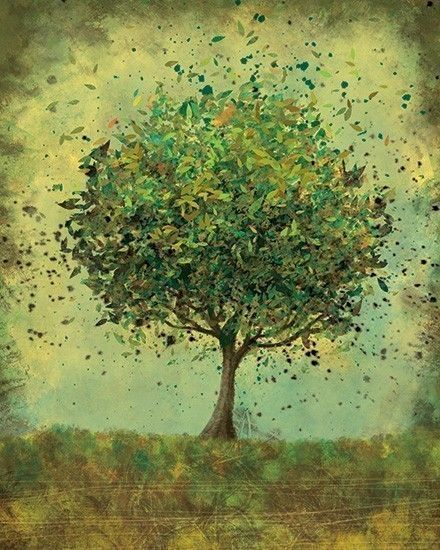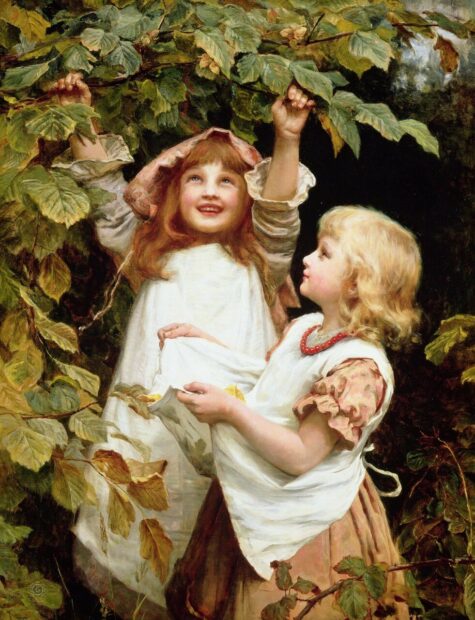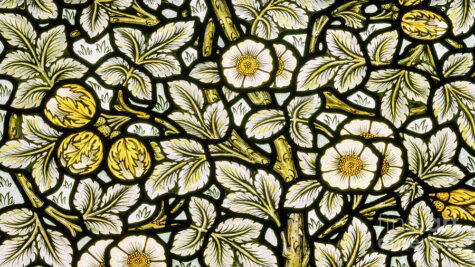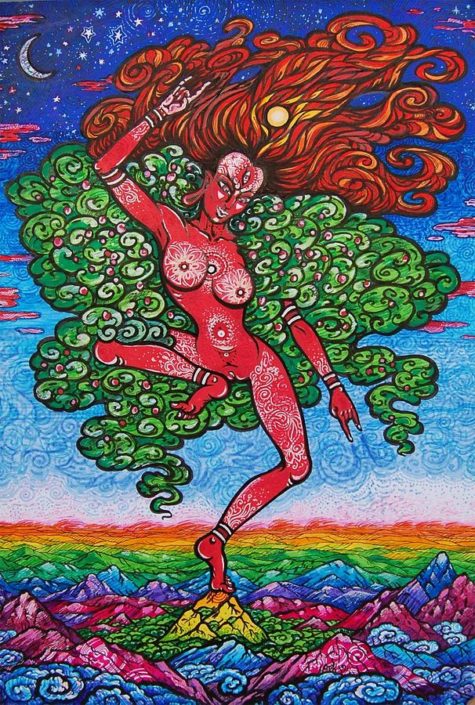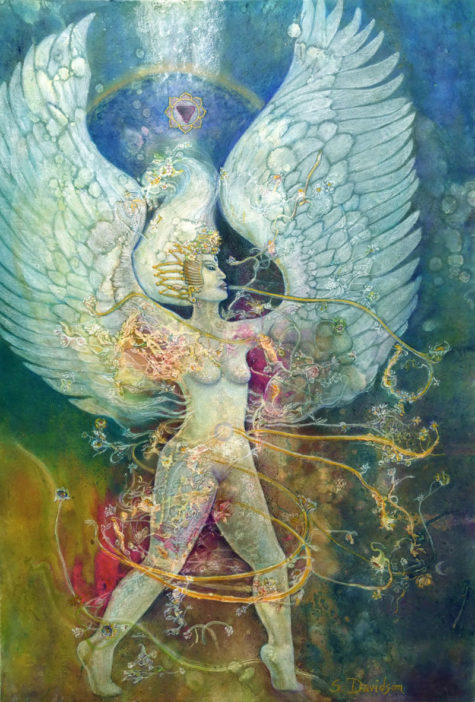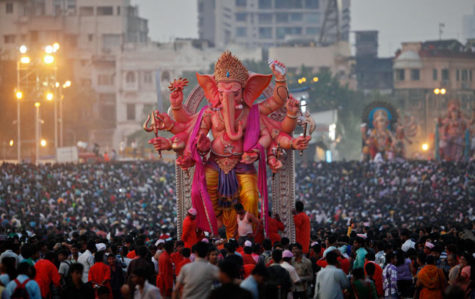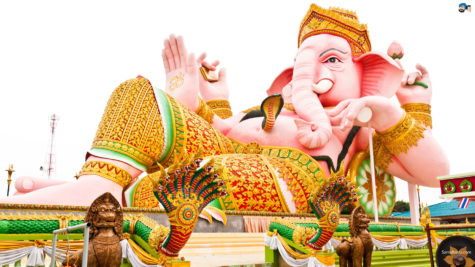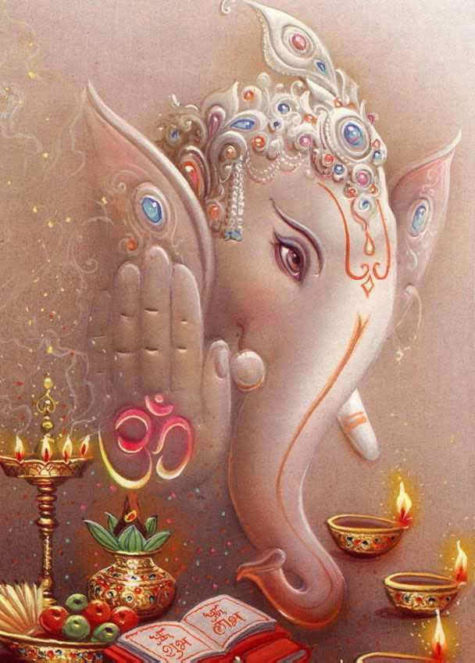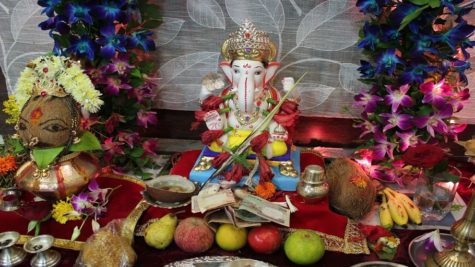September
In the Old Icelandic Calendar, winter begins on the Satyrday between Hunting 11th and 17th. This festival marks the beginning of winter, which was often celebrated around the middle of October. Winter Nights celebrates the bounty of the harvest
- Also referred to as: Vetrablot, Vetrnætr, Winterfylleth, Veturnætur, Winter Finding, and Winter Day.
Winter Nights is a more accurate term, considering that the passage of time was marked by nights, not days. An example of this can be seen from Anglo-Saxon times as it applies to the English word ‘fortnight’ as a reckoning of time for two weeks.
Just as traditional Jewish sabbat begins at sundown on Friday until sundown on Saturday… it appears that the festivities traditionally kicked off at night. This allows participants to work to prepare for the party during daylight hours too. On occasion you may even see reference to the term Winter Finding.
Some groups use this as being synonymous and interchangeable with the term Winter Nights. But others will call the harvest celebration at the autumnal equinox Winter Finding, and call the later October celebration Winter Nights instead.
Though we know the various names of the holiday, we don’t really know how people celebrated Winternights. Some people honored Freyr at this holiday, where He was given a sacrifice to thank him for the year’s harvest.
Some traditions honor Freya and the fertility and protective spirits called Disir, that She leads (often the Disir are seen as our female ancestors). Glory is given to Freya, a libation of ale, milk, or mead was poured into the soil as an offering to the Disir and the Earth itself.
We know that in Sweden, an event called an Alfarblot was held around the same time of year. It was a private event where ale was served and livestock were likely sacrificed. As Freyr is the lord of Alfheim, this event may be related to Winternights.
Some people honored Odin instead; some honored the dísir (female ancestors), some honored the alfar (elves; or male ancestors). Some people likely did a mix of all of the above.
When celebrating Winternights with a definite disir/alfar focus. Food is shared at a potluck based on recipes passed down to us from our ancestors or foods that they preferred. A sumbel is in their honor, honoring specifically those who have passed on in the last year, both animals and humans, and then sharing the stories of the food we brought, and of our ancestors of blood and of spirit. This can be an intimate, moving ritual, and a great way to start the winter season.
- A Sumbel is a formal drinking ritual composed of toasting, hails, oath-taking, the recitation of poetry or song, and other forms of verbal expression.
A Winternights sumbel might start with a round to Freyr to thank Him for the past harvest and to ask for prosperity in the days ahead. A round is included for the recently departed and for our ancestors of blood and of spirit as well.
So today we have a range of practice as it applies to this time of year. Some opt to celebrate it at the time of the autumnal equinox for sheer simplicity. But many others will instead decide to observe Winter Nights in October as that’s more in keeping with the traditional calendars.
Others split the celebration up, observing a Harvest-tide celebration in September, and then in October they will instead opt to specifically come together to honor the ancestors.
If you have children, incorporating ancestor veneration at this time helps to sync up to the Halloween and Day of the Dead décor that is on the market, and allow the children to have some similar dialogue among their peers at school. What Winternights does have in common with modern Samhain and Day of the Dead traditions, is that we both honor ancestors with their favorite foods and drink.
A Blot for Winternights
I hope all Heathens have a satisfying Winternights for both the living and the dead this year . Hail the disir! Hail the alfar! Hail Freyr!
- Hallowing:
Thunar, Guardian of Asgard and Midgard, We ask you to ward this stead well for Winternights. Hail Heimdall warder of Bifrost we ask that you hold us in your great sight.
- Purpose:
We gather to honor the Aesir and Vanir on this Winter Night and give thanks for the fruits of this past year and the Harvest we have gathered from the Earth. We also look back on the past year and measure our time that it was used wisely; to look at the future to find our way; like the Ice of time scrubbing away the impurities to leave behind the clear work.
We ask the dwellers of Asgard to give us the strength to and to help us provide for our kinsman in preparation for the long Winternachten yet to come.
- Hails:
Hail Wodan, The All Father, for your wisdom and forethought in guiding us forward through the winter to come and for the knowledge you have shared with us.
Hail Wodan!
Hail to Fro Ing for the bountiful harvest you have brought to us this eve.
Hail Fro Ing!
Hail to Freya for the love and life we hold to our hearts.
Hail Freya!
Hail to all the Ases and Wanes for the mighty work that you do.
Hail the Ases and Wanes!
And Hail to our Ancestors and Wights of the land. Hail to the All who have crossed Bifrost before.
Hail the Ancestors!
- Welcoming:
We welcome all the Ases and the Wanes. We welcome all the Wights, Alfs and Ancestors who have gone before us. We Welcome all the Wights and Landvaetter to witness this rite rightly done so that you shall see the truth in our hearts.
Heilsa all!
The time of Winternights marks the passing of Sunna farther down into the sky. This time of year marks the Mother Earth going to sleep to be rested for the coming Spring; for Fro Ing to renew the fertility of the Earth to bring forward the crops of our folk.
We look forward to Yule that is fast approaching. And we honor our ancestors that have gone before us. We look back over this past year with pride of the work rightly done. We look forward to prepare for the coming of winter, to protect our hearth and Kin from the cold of the frost giant called Winter, to open our hearths to those in need.
With this hallowed drink, brewed with the hand of Aegir the Brewer of Asgard we give our toasts:
- Wassail All!
Hail to the Aesir and Vanir!
Hail to the Alfs and the Dises!
Hail to our Ancestors!
Hail to the Landvaetter and all Wights of weal!
We now offer this sacrifice and return it to the Earth.
- Personal Hails!
Heilsa!
- The Blessing and Ending
We thank the Gods and Goddesses, the Aesir and Vanir for the gifts that we have and the gifts we may receive, May you find us fitting to receive them.
Heilsa All!
Sources:
- Asatru Utah
- Patheos
- Wyrd Designs
- Erich Shall
- Grundair Karlson
As the year comes to a close and Samhain approaches, the Ivy moon rolls in at the end of the harvest season when successes and losses must be accounted for. Ivy often lives on after its host plant has died, and reminds us that life goes on and there is time to be reborn.
The Ivy teaches us that restrictions are necessary to help us hone our skills. During this month remember that your enemies are your teachers and that opposition is a blessing in disguise. Focus on energy that strengthens your resolve.
- Dates: September 30 – October 27
- Celtic Name: Gort (pronounced go-ert)
- Language of Flowers: Friendship, Fidelity, Marriage, Assiduous to Please (as a sprig with trendrils)
- Qualities: Fertility, Fidelity, Immortality, Resurrection, Rebirth, Healing, Feminine, Winter
- Themes: Rebirth, Cleansing, Self-improvement, Boundaries, Healing, Protection, Cooperation
The Month of the Ivy is the perfect time to banish the negative from your life. Avoid the things that are bringing you negativity, work on improving yourself, place a barricade between you and the things that are toxic to you.
Energy that boots your sense of responsibility will make you ready for what lies ahead. Be prepared to take the long-term view and accept and celebrate your life as it is right now. Trust that the Ivy Moon will prepare you to receive an answer to your prayers at exactly the right time. Be patient and you will be guided to your answer.
You can use the month of the Ivy Moon for energy and rituals for protection, or harness its energy to make charms that will strengthen resolve and help you face challenges. It can also be used in magick performed for cooperation, and to bind lovers together.
Ivy the Survivor
The Ivy Celtic tree sign is blessed with the ability to overcome all odds and can survive in any situation. People born under the energy of the Ivy are loyal, compassionate and have a sharp intellect. Life may be unfair to them at times, but they endure the troubles with soulful grace. They can be drawn to the spiritual world and their faith is deeply rooted. Ivy signs are charming, soft-spoken and have a good compatibility with the Oak and Ash signs.
People born under the Celtic tree Ivy sign are very giving. They are the people that are always willing to help those less fortunate and in need. The Ivy sign is very connected spiritually and their faith often sees them through the tough times they often experience.
They can be on the shy side, but have a very social nature. They are charismatic and charming and can be quite a delight in social situations.
Ivy Magick and Lore
The Celts interpreted the ivy to symbolize friendship and connection to others. Once those connections were established the lesson progressed to also demonstrate growth through the many twists and turns of regular life. Ivy is very hearty also, which goes to further the message of growing even during challenging times in our lives. Even after fire or severe weather, the ivy would return to growing, signifying the strength and will of the human spirit; surviving against all odds.
Ivy is an autumn and winter plant – a plant of fertility and rebirth with a feminine energy. She is a healing and nourishing plant that gives and receives support and provides insight – going her own way, yet forming connections as part of a community.
Ivy is friendship and fidelity, the loving ties of partnership and family – a plant to see us through hard times with loving kindness. Placing ivy leaves, lily petals and lilac flowers in a blue bag will prevent you from returning to a destructive relationship.
Most ivy plants have five-pointed leaves, making them a symbol of protection (signifies the harmony of the elements unified by common bonding energy). To guard against accidents while driving, carefully secure an ivy leaf on the dashboard of your car.
Ivy grows in a spiral formation reminding us that each cycle of the seasons brings us closer to the center, to spirit.
Churches have used holly and ivy for their Christmas décor since at least the 15th century, with holly representing Jesus and ivy, the Virgin Mary.
It was believed that ivy should only ever be brought into the house for Christmas and was unlucky at any other time – along with all the other Christmas decorations, you should be sure to remove the ivy by Twelfth Night, though!
On New Year’s Eve, you could lay an ivy leaf in water and leave it there, returning to it on Twelfth Night – if the ivy was green and healthy, it augured that the upcoming year would be happy. If, however, the ivy leaf had turned black, illness would come. Worst of all, if the ivy leaf was decayed and disintegrating, an untimely death was foretold!
Grow ivy vines around the front door of your house to prevent negativity from entering your home. A house covered in ivy was believed to be lucky – the ivy would bind the family together and bring wealth to the inhabitants. Ivy also protected the householders from witchcraft and the Evil Eye!
If ivy on a house withered and died, disaster would unfold – Welsh folklore said, specifically, that the house would pass to others.
Ivy leaves swept around an area were thought to cleanse an area of negativity and ill-fortune, and bring good luck instead. But you should take care not to use the ivy leaves picked from a church! To pick just a single ivy leaf from a church meant sickness would befall you!
House Protection With Ivy
Utilize the magic of ivy to protect your home from negative influences. You will need:
- A black candle
- Lots of ivy branches
Light the candle and say, “I call upon the spirits of this place, come in peace.”
Make a circle of ivy branches on the floor and step into the center.
Turn to the north and recite, “Spirits of the Earth protect me.”
To the east say, “Spirits of air protect me.”
To the south say, “Spirits of fire protect me.”
To the west say, “Spirits of water protect me.”
Place the branches that formed your circle at the boundaries of your property.
Sources:
The Autumn Equinox – or Mabon – is a time of harvesting and celebration. Often called “Witches’ Thanksgiving,” it’s a prosperity holiday which asks us to gather with one another to count our blessings, connect, and re-balance. The nights are about to become longer, and soon we’ll be turning inward.
Mabon is a celebration of life and death, and giving of life again, the cycle of the seasons. Mabon is a time to enjoy the fruits of a hard year’s labor, to stock up for the long winter. No matter how you celebrate Mabon, it is important to know that Mabon a time for giving thanks.
The Mothman Festival is an annual gathering commemorating the visit of the mysterious entity known only as “The Mothman.”
This event is held every third weekend in September that commemorates the 1966 Point Pleasant, West Virginia Mothman sighting, which gave birth to the infamous red-eyed winged legend. People from all over the world gather to celebrate their favorite cryptid during this one of a kind event.
A Terrifying Tale
In November 1966, gravediggers working in a cemetery in Clendenin, West Virginia, spotted a strange, man-like figure in the trees above their heads.
A few days later, two young couples from Point Pleasant reported being chased by a large creature with 10-foot wings whose eyes “glowed red” while driving near a former military munitions site outside town.
Sightings of what area newspapers dubbed the “Mothman” continued throughout the next year, oftentimes leaving witnesses with a deep sense of dread. Many locals believed the Mothman lived in a vacant nuclear power plant outside Point Pleasant, perhaps the escaped product of some secret government experiment.
The sightings came to an abrupt halt in December 1967, however, after a horrific tragedy in Point Pleasant. The Silver Bridge—which carried U.S. Route 35 over the Ohio River—collapsed on under the weight of heavy rush hour traffic, killing 46 people.
Coincidence?
The fact that the collapse was later attributed to a faulty suspension chain didn’t stop the conspiracy theories. In 1975, writer John Keel wrote a book titled The Mothman Prophecies linking the bridge collapse with the Mothman sightings. In it, Keel suggested that the sightings were actually bad omens about the impending bridge collapse.
In 2002 the book was turned into a movie starring Richard Gere and Laura Linney, and the spooky West Virginia legend exploded onto the national stage.
The small town of Point Pleasant fully embraced its most famous resident, welcoming the annual Mothman Festival in 2002, installing a 12-foot metallic statute of the creature in 2003, and opening the Mothman Museum and Research Center in 2005.
And in the news…
POINT PLEASANT, WV (WCHS/WVAH) — Hunters in Mason County may need to be on the lookout for something other than deer when they hit the woods this week.
The Point Pleasant Mothman is a local legend that over the years has gained worldwide fame.
There hadn’t been any recent sightings of the red-eyed creature recently, but that changed Sunday evening, when a man who says he was driving along State Route 2 saw something jump from tree to tree. He pulled off the road and snapped some pictures.
The man declined an on-camera interview, but was adamant the pictures had not been doctored. He said he recently moved to Point Pleasant for work and didn’t even know about the legend.
In the pictures, the creature appears to have wings with pointed tips and long legs, bent at an awkward angle.
Point Pleasant locals such as Carolin Harris believe the pictures could be real because there have been so many other sighting over the years.
“I definitely know the Mothman is real,” Harris said.
Harris has owned The Mothman Diner in Point Pleasant for 48 years. She also helped start the Mothman Festival. Harris said there have been too many sightings of the Mothman for her not to believe.
“First responders and the sheriff’s department that I talked to definitely made a believer out of me.” Harris said.
Some believe The Mothman is a bad omen, only appearing when catastrophe is about to strike. There have been many claims the winged, red-eyed creature was seen right before the Point Pleasant Silver Bridge collapsed in 1967.
Harris has met many Mothman believers over the years who visit her diner.
On Monday, Karen and Ralph Smith were patrons at the diner. The couple was traveling from Florida to Pennsylvania, but decided to stop off in Point Pleasant to visit the Mothman Museum.
Karen Smith said she hopes she can add herself into the “believer” category.
“You have eyewitnesses. It does have the potential to be real, and I want to believe,” Smith said.
The Smiths said the Mothman pictures look real to them. So Eyewitness News asked Jeff Wamsley, the local Mothman expert and owner of the Mothman Museum.
Wamsley said with modern technology, it’s almost impossible to know for sure if the pictures are real.
Whether the pictures are real or not, the benefits the legend of the Mothman brings to the town of Point Pleasant are very real.
“It’s a good thing. It brings lots of people to the area. He’s here to stay,” Harris said.
The Wikipedia Story
On November 15, 1966, two young couples from Point Pleasant, Roger and Linda Scarberry and Steve and Mary Mallette, told police they saw a large grey creature whose eyes “glowed red” when the car’s headlights picked it up. They described it as a “large flying man with ten-foot wings”, following their car while they were driving in an area outside of town known as “the TNT area”, the site of a former World War II munitions plant.
During the next few days, other people reported similar sightings. Two volunteer firemen who saw it said it was a “large bird with red eyes”. Mason County Sheriff George Johnson commented that he believed the sightings were due to an unusually large heron he termed a “shitepoke”.
Contractor Newell Partridge told Johnson that when he aimed a flashlight at a creature in a nearby field its eyes glowed “like bicycle reflectors”, and blamed buzzing noises from his television set and the disappearance of his German Shepherd dog on the creature.
Wildlife biologist Robert L. Smith at West Virginia University told reporters that descriptions and sightings all fit the sandhill crane, a large American crane almost as high as a man with a seven-foot wingspan featuring circles of reddish coloring around the eyes. The bird may have wandered out of its migration route, and therefore was unrecognized at first because it was not native to this region.
Folklorist Jan Harold Brunvand notes that Mothman has been widely covered in the popular press, some claiming sightings connected with UFOs, and others claiming that a military storage site was Mothman’s “home”.
Brunvand notes that recountings of the 1966–67 Mothman reports usually state that at least 100 people saw Mothman with many more “afraid to report their sightings” but observed that written sources for such stories consisted of children’s books or sensationalized or undocumented accounts that fail to quote identifiable persons.
Brunvand found elements in common among many Mothman reports and much older folk tales, suggesting that something real may have triggered the scares and became woven with existing folklore. He also records anecdotal tales of Mothman supposedly attacking the roofs of parked cars occupied by teenagers.
Conversely, Joe Nickell says that a number of hoaxes followed the publicity generated by the original reports, such as a group of construction workers who tied flashlights to helium balloons. Nickell attributes the Mothman stories to sightings of barn owls, suggesting that the Mothman’s “glowing eyes” were actually red-eye effect caused from the reflection of light from flashlights or other bright light sources.
Benjamin Radford points out that the only report of glowing “red eyes,” was secondhand, that of Shirley Hensley quoting her father.
According to University of Chicago psychologist David A. Gallo, 55 sightings of Mothman in Chicago during 2017 published on the website of self-described Fortean researcher Lon Strickler are “a selective sample”. Gallo explains that “he’s not sampling random people and asking if they saw the Mothman – he’s just counting the number of people that voluntarily came forward to report a sighting.” According to Gallo, “people more likely to visit a paranormal-centric website like Strickler’s might also be more inclined to believe in, and therefore witness the existence of, a ‘Mothman’.”
Some pseudoscience adherents (such as ufologists, paranormal authors, and cryptozoologists) claim that Mothman was an alien, a supernatural manifestation, or a previously unknown species of animal. In his 1975 book The Mothman Prophecies, author John Keel claimed that the Point Pleasant residents experienced precognitions including premonitions of the collapse of the Silver Bridge, unidentified flying object sightings, visits from inhuman or threatening men in black, and other phenomena.
Festival and Statues
Point Pleasant held its first Annual Mothman Festival in 2002. The Mothman Festival began after brainstorming creative ways for people to visit Point Pleasant. The group organizing the event chose the Mothman to be center of the festival due to its uniqueness, and as a way to celebrate its local legacy in the town.
According to the event organizer Jeff Wamsley, the average attendance for the Mothman is an estimated 10–12 thousand people per year. A 12-foot-tall metallic statue of the creature, created by artist and sculptor Bob Roach, was unveiled in 2003. The Mothman Museum and Research Center opened in 2005.
The festival is held on the third weekend of every September, hosting guest speakers, vendor exhibits, pancake-eating contests, and hayride tours of locally notable areas.
In June of 2020, a petition was started to replace all Confederate statues in the United States with statues of Mothman. As of July 2020, the petition has garnered over 2,000 signatures.
Sources:
According to Tibetan and Vedic astrology, there are a cluster of stars, called the ‘Rishi’ stars, that ‘appear’ for one week each year – usually during the 8th lunar month (September). According to Tibetan astrology, the Rishi stars will be ‘out’ this year from Sept. 9-15. In Tibetan this is known as ‘Karma Rishi.’
According to Hindu legend, these stars were once great sages of the past, who, upon their death, ascended up into the heavens and became these stars. When they are visible in the night sky, their light is said to possess special healing powers that transform all water into a healing nectar.
Some sources state these stars are the Ursa Major, or the ‘big dipper,’ also known as the Sapta Rishi stars, who are associated with the seven great Rishis of Vedic lore. Other sources say this is the Canopus star, which is associated with the Rishi Agastya, and is said to be the ‘cleanser of waters.’
Typically, Tibetan doctors and healers would place buckets of water outside during this time, then use this water for making their medicines. Lama Dawa remembers how His Holiness Matrul Rinpcoche – a great Tibetan physician – would then boil this water down, thus concentrating it, then use this water to make the herbal medicinal pills, and also to consecrate the water with healing mantras.
Another way of benefiting from this healing water is to bathe in pools, ponds or rivers during this time. Or, collect water in buckets and use that for bathing. Any water – whether it is ocean, river, stream, or water in pools, is imbued with the healing qualities of the stars.
This water can be used to make healing tinctures, or for giving to pets and plants. Even the water in our own bodies can be ‘blessed’ and purified by this special healing energy by exposing your body to the night sky when the stars are out.
It is a particularly auspicious time to do practices such as the Vajra Armor mantra, which is used to consecrate water, or Medicine Buddha mantras and offering pujas.
Prayer:
Rangrig Dorje Rinpoche offers this prayer and mantra to be said while taking a bath outside under these stars:
༈ཇི་ལྟར་བལྟམས་པ་ཙམ་གྱིས་ནི། ལྷ་རྣམས་ཀྱིས་ནི་ཁྲུས་གསོལ་ལྟར།
JI-TAR TAM-PA TSAM-GYI NI / LHA-NAM KYI-NI TRU-SOL TAR /
ལྷ་ཡི་ཆུ་ནི་དག་པ་ཡིས། དེ་བཞིན་བདག་གིས་ཁྲུས་བགྱིའོ།
LHA-YI CHU-NI DAG-PA YI / DE-ZHIN DAG-GI TRU-GYI O /
- Mantra:
ཨོཾ་སརྦ་ཏ་ཐཱ་ག་ཏ་ཨ་བྷི་ཥེ་ཀ་ཏ་ས་མ་ཡ་ཤྲཱི་ཡེ་ཧཱུྃ༔
OM SARWA TAT’HAGATA ABHISHEKA TA SAMAYA SHRI YE HUNG
- Aspiration:
འདི་ནི་ཁྲུས་མཆོག་དཔལ་དང་ལྡན། ཐུགས་རྗེའི་ཆུ་ནི་བླ་ན་མེད།
DI-NI TRU-CHOG PAL-DANG DEN / T’HUG-JE’I CHU-NI LA-NA MED /
བྱིན་རླབས་ཡེ་ཤེས་ཆུ་ཡིས་ནི། ཅི་འདོད་དངོས་གྲུབ་སྩོལ་བར་མཛོད།
JIN-LAB YE-SHE CHU-YI NI / CHI-DOD NGO-DRUB TSAL-WAR DZOD
Western Astrology:
Western astrologer, Terry Nazon, offered this information about the Sapta Rishi Stars:
“They are the fixed stars of Ursa Major the Big Dipper. They are always visible…but during that time in September as the constellation late Leo and early Virgo is right above us in the night sky…they are closest then and right above us.
Because the earth is moving and just like the moon moves across the night sky so will the big dipper…it can also be that the Sun is activating them…for planets and stars to be effective they have to be triggered by a planet or star like the sun.
If you are “charging” water you will want to place the water where it receives the most exposure. For instance maybe there’s tree blocking the Big Dipper in your front yard…and remember, we are made up of 60 % water and in ancient Kabbalah, the text said to bath ourselves in this planetary “rain” they called it.”
The Rishi stars:
- 1. Dubhe The Bear:
Astrology, arrogance, psychic power, destruction; aka Krathu, one of the 7 Rishis (Hindu sages) in Ursa Major; Bast Isis, the Egyptian goddess; “The Eye”; “Heaven’s Pivot”
- 2. Merak:
Prudent, restrained, mistrustful, self-controlled (but angry when roused), love of command, power to achieve, good with animals; Pulaha, one of the 7 Rishis (Hindu sages) of Ursa Major
- 3. Phecda:
Civilising influence, tamer of beasts, transmission of divine knowledge; Pulasthya, one of the 7 Rishis (Hindu sages) of the Great Bear, Ursa Major; bloodbaths, assassinations, riots, sexual perversion
- 4. Tania Borealis:
In the right hind paw of Ursa Major, along with Tania Australis, this star was part of an early Arabian constellation, The Gazelle, of which this group is the “Second Leap”. The Great Bear is mainly martial in action, considered unfortunate for nations and kings.
- 5. Megrez:
Spiritual sight; creativity; violence; Atri, one of the 7 Rishis (Hindu sages), the ruling star of the Great Bear, Ursa Major
- 6. Alioth, The Black Horse:
Suicide among women; danger in pregnancy; Angirasa, one of the 7 Rishis (Hindu sages) in Ursa Major
- 7. Mizar:
Connected with fires of a catastrophic extent and mass calamities; Vasishta, one of the 7 Rishis (Hindu sages) of Ursa Major
- 8. Alula Borealis:
Hindmost foot of Ursa Major. As the northern Alula, it is more fortunate. Associated with female infidelity & revenge. The Great Bear gives a quiet, prudent, suspicious, mistrustful, self-controlled, patient nature, but an uneasy spirit; great anger when roused.
The Canopus Star:
The Canopus star is the second brightest star after Sirius. In Indian Vedic literature, the star Canopus, known as the ‘smiling star’ is associated with the sage Agastya, one of the ancient rishis (the others are associated with the stars of the Big Dipper). Agastya, the star, is said to be the ‘cleanser of waters’ and its rising coincides with the calming of the waters of the Indian Ocean.
Canopus is a bright star most easily visible in the Southern Hemisphere. It is in the constellation Carina, the keel. The star is of a fairly rare type, considered a class F giant on the main sequence of stars. This means it has a mass close to that of the sun.
Because the star’s spectral class is not well studied, it is difficult to establish how far away Canopus is. Parallax measurements with the Hipparcos satellite have established it to be about 313 light-years away.
Canopus can’t be seen from most locations in Europe and North America. Observers in northern latitudes south of 37°N can find the star below Sirius in the southern sky on winter evenings. Canopus is at its highest in February around 9 pm. It is located about 36 degrees to the south of Sirius.
In science fiction, Canopus is perhaps best known for being the parent star for Arrakis, a dusty desert planet in the “Dune” universe.
Canopus is used in space navigation to adjust the position of spacecraft in space. Many spacecraft are equipped with a special camera called the Canopus Star Tracker.
Sources:
The Vine is a symbol of both happiness and wrath — passionate emotions, both of them. Do magical workings this month connected to the Autumn Equinox, or Mabon, and celebrate garden magic, joy and exhilaration, wrath and rage, and the darker aspect of the mother goddess. Use the leaves of the Vines to enhance your own ambition and goals. during this month. The month of Vine is also a good time to get balanced, as there are equal hours of darkness and light.
This is the time of great abundance. Spells concerning happiness and great passion are best done at this time. This is the perfect time for your ambitions, goals, and dreams.
- Dates: September 2 – September 29
- Celtic Name: Muin
- Language of Flowers (Bramble): Lowliness, Remorse, Envy,
- Qualities (Bramble): Flexibility, Tenacity, Fierceness, Beauty Reward for Hard Work,
- Themes: Harvest, Reward, Tenacity, Vigor, Health and Healing.
The Autumn Equinox, when night and day are equal length, occurs during the month of the Vine and will help you to realign your energy to prepare for the dark half of the year.
This is a time to value input from others because collaborative work brings insights and networks that are made in the time of the Vine may prove useful in the forthcoming months.
Focus on energy that resolves, cast peace to end an argument or use prosperity energy to help you settle bills and pay off existing debts. Energy must be balanced with action now, so use nature’s last burst of energy, visible in the vibrant autumn colors, to inspire you to complete projects begun earlier in the year.
Invest in your health by eating foods packed with vitamin C to stave off colds as the weather declines. Boost your energy levels with herbal drinks.
Use your energy during the month of the Vine to restore peace to troubled relationship and to bring prosperity and fertility into your life.
Note:
The Celtic word for Blackberry, taken from the ogham tree letters is ‘muin’. Sometimes, people will interpret ‘muin’ as ‘vine’ – but a vine as we now know it (a grapevine) was not a native plant in Celtic Britain and Ireland where the ogham evidence we have derives from – and so it is now more commonly thought that ‘muin’ refers to the Blackberry. Both fruits (grape and Blackberry) are used in money energy and are linked to fairies.
Vine the Equalizer
The Vine is another shapeshifter of the Celtic astrology. This is due to the fact that people born under this sign are born within the autumnal equinox. This makes them unpredictable, contradictive, and often indecisive. They can see the good and bad in each story, which makes it hard for them to pick a side. However, they are always sure when it comes to their taste in food, wine, music and art – they have a soft spot for guilty pleasures. Vines have a thing for luxury and refinement. Willow and Hazel can suit their classic style.
They are quiet, discreet, they never draw attention on them, they do not raise their voice and very often you do not notice when they are around. Nevertheless, the saying “Still waters run deep” describes them well. Hazel people are usually very intelligent, they have great memory, good intuition and the ability to learn quickly. They come across as plain but potent people. Exactly this type of people used to be considered a saint or blamed for witchcraft a few centuries ago.
Hazel people usually achieve their goals easily because they are able to take advantage of all their abilities. In relation to others, they tend to be friendly, helpful and easy-going. They can be very patient, understanding and selfless, and they are very generous to their friends. They always start everything with love and goodness because they believe that is the easiest way to achieve things.
Thanks to their foresight and high intelligence they often come up with unusual ideas and solutions that they have thought through to the smallest details.
Although Hazel people tend to be successful in life, they do not like to be spoiled by luxury. They are perfectly adaptable and even little things can make them happy. Fluctuations in their mood are seldom caused by external conditions. So there are moments in their lives when it is better to get out of their way. The same is true about their love life; most of the time they are loving partners, but sometimes they become very grumpy. Still, life with Hazel people is interesting and pleasant, albeit full of change. They are usually reliable and faithful partners in marriage.
Magick and Lore of the Bramble
Our Celtic ancestors valued the Bramble (or Blackberry) as a symbol of spiritual wisdom, emotions, and initiation.
The Bramble shows us flexibility, tenacity, and vigor – and also the importance of connection as the Bramble branches reach out and connect all the other trees and bushes in their thorny embrace. Blackberry is health-giving and healing – a nourishment for our body and soul.
Blackberry is about good preparation (gathering for winter), a healthy reward for hard work and risks taken (blackberrying at risk of prickles), and the importance of being ready to act at the right time (picking brambles when they are ripe, but before they are taken by the witches’ or fairies’ poison).
It was often advised to pick blackberries only in the waxing moon, to gain protection from ill-will.
Many traditions over the correct timing of Blackberry picking have arisen, most focusing on the specific date after which blackberries should never be picked – variously advising dates from the end of August, Michaelmas Day (29 September), or the end of September, or Halloween (31st October) as the blackberries will have been poisoned, spat on, or peed on by fairies, witches, or even the Devil.
It’s likely that the varying dates relate to how far north or south the blackberries grow, so relating to the change in weather – as the late crop of blackberries taste sour in any case and you could certainly believe that they’d been poisoned by witches (or worse, peed on by fairies) were you to taste one.
Elsewhere, blackberries were never eaten – especially in France and Majorca where they believed brambles were made into Christ’s crown of thorns – while in Brittany, it was because they were the food of the fairy folk.
Magick and Lore of the Vine
The Vine month is a time of great harvest — from the grapes of the Mediterranean to the fruits of the northern regions, the Vine produces fruits we can use to make that most wondrous concoction called wine.
The Vine is fast-growing, prolific, and none like each other. They are all unique and adapt with things growing around them. The most valued vine was the grape vine, as it was the source for wine.
The vine is the only plant in the Celtic Tree Calendar that is not native to Britain, although it features in much Bronze Age art. It was cultivated by migrants from Southern Europe.
The name vine comes from the word ‘viere’, meaning ‘to twist’. This refers to the Druidic concept of spiritual development.
A Spell For Peace
Use your energy to bring peace to a troubled relationship or to help heal any conflict or dispute. You will need:
- A white candle
- A white ribbon
- Pen and paper
Hold the candle and say, “I dedicate this candle to peace.”
Write a list of grievances that caused the conflict. Light the candle and focus on sending love to the other party. Burn the list in the flame saying, “For the sake of peace, I let it go.”
Light the candle for a few moments each night and focus on peace. Tie the ribbon to a Bramble or grapevine. When the leaves have all fallen, peace will be restored.
Sources:
There is a lot to celebrate in September. This is a list of pretty much everything that goes on during the ninth month of the year. Many of these dates change from year to year. The days that change are marked with this » symbol.
September Lore and General Info

Astronomical Events
- Sept 6 » New Moon
- Sept 7 thru Dec 10: Taurids Meteor Shower
- Sept 20 » Full Moon – Barley Moon, Harvest Moon
- Sept 22: Autumn Equinox – dates may vary slightly from year to year
Astrological Events
Depending on which astrological system you adhere to, these are the signs that show up in September of 2021. Be aware that some of these dates will vary from year to year. Unlike the Sun signs which might just shift by 1 or 2 days, the dates of the various Moon signs will vary widely from year to year. The same holds true for the Chinese Zodiac. The Celtic Tree Signs are based on an arbitrary system and stay the same from year to year.
The September Sun begins in Virgo and finishes up in Libra:
- Aug 22 thru Sep 22 » Sun in Virgo
- Sep 22 thru Oct 22 » Sun in Libra
The moon cycles through the signs as follows:
- Aug 29 – Sept 1 » Moon in Gemini
- Sept 1 – Sept 3 » Moon in Cancer
- Sept 3 – Sept 5 » Moon in Leo
- Sept 5 – Sept 8 » Moon in Virgo
- Sept 8 – Sept 10 » Moon in Libra
- Sept 10 – Sept 12 » Moon in Scorpio
- Sept 12 – Sept 14 » Moon in Sagittarius
- Sept 14 – Sept 16 » Moon in Capricorn
- Sept 16 – Sept 18 » Moon in Aquarius
- Sept 18 – Sept 21 » Moon in Pisces
- Sept 21 – Sept 23 » Moon in Aries
- Sept 23 – Sept 26 » Moon in Taurus
- Sept 26 – Sept 28 » Moon in Gemini
- Sept 28 – Oct 1 » Moon in Cancer
You will notice that the Moon might begin the day in one sign and by the end of the day may have moved into another sign, so timing matters if you are wanting to be precise.
The Celtic Tree Signs in September:
- Aug 5 thru Sept 1: Month of the Hazel Tree
- Sept 2 thru Sept- 29: Month of the Vine
- Sept 30 thru Oct- 27: Month of the Ivy
- Sept 21 thru Autumn Equinox: Aspen/Poplar
The Alternative Celtic Zodiac is as follows:
- Pine: Aug 25 – Sept 3
- Willow: Sept 4 – Sept 13
- Lime: Sept 14 – Sept 22
- Alder: Sept 23 (Autumnal Equinox)
- Hazel: Sept 24 – Oct 2
The Chinese Calendar and Zodiac
We are currently in the year of the Ox (sometimes referred to as the Cow). Each Month is also assigned a specific animal. Here’s what shows up in September 2021.
- Monkey » Aug 7 – Sep 6 (Chinese Zodiac – Stem Branch Calendar)
- Monkey » Aug 8 – Sep 6 (Lunar Calendar – 7th Month)
- Chicken » Sept 7 – Oct 7 (Chinese Zodiac – Stem Branch Calendar)
- Chicken » Sept 7 – Oct 5 (Lunar Calendar – 8th Lunar Month)
Note: The traditional Chinese Astrology birth chart is built by the Chinese Stem Branch Calendar, not the Chinese Lunar Calendar, which I think is really confusing. Because of a difference in time zones, the lunar months will have a different pattern between China and the USA.
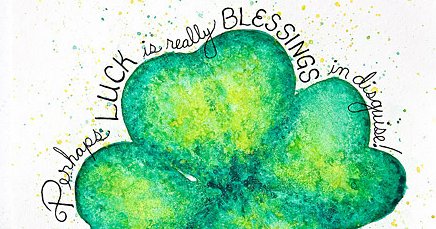
Lucky and Unlucky Days
You might want to plan moving, traveling, major purchases, court dates, and weddings around these dates, avoiding the unlucky days and utilizing the lucky ones. Interestingly, the 18th of September is both lucky and unlucky.
- These are the lucky days in September:
4, 8, 17, 18 and 23. - These are the unlucky days in September:
9, 10, 16, and 18.
Fatal Days
The third day of the month September
And tenth bring evil to each member.
Holidays and Holy Days
Many of the holidays begin on the eve of the night before and end on the eve of the day of. It’s also important to remember that the dates of archaic festivals and feast days may vary widely depending on the source.
September 2
- 2 » Dakini Day (Tibetan)
- 2 » Day of Ekadashi (Hindu)
- 2 thru 13: Ganesh Chaturthi
September 4
- 4: Ludi Romani
September 5
September 6
- 6 » Labor Day
September 7
- 7 » The Noumenia
- 7 » Rosh Hashanah
September 8
September 9
- 9: Double Ninth Day (alternatively celebrated on the 9th day of the 9th Lunar month)
- 9 thru 15: The Rishi Stars appear
September 11
- 11: Patriot Day
September 13
- 13: Ides of September – The Epulum Jovis
September 16
- 16 » Yom Kippur
September 17
- 17 » Friday the 17th
- 17: Constitution Day
- 17 » Day of Ekadashi (Hindu)
September 19
- 19: The Fast of Thoth – this day-long fast honors the Egyptian god of wisdom and magic.
September 20
- 20 » Keirō no Hi – Respect for the Aged Day (Japan)
- 20 » Chinese Moon Festival -The Festival of Chang O, on the full moon nearest the autumnal equinox. Some Chinese celebrate this day as the moon’s birthday.
September 21
- 21 » Sukkot
- 21: Birthday of Athena, Greek Goddess of Wisdom also known as Sophia
- 21: The Feast of the Divine Life – honors the great goddess in her three-fold aspect as mother (creator), daughter (renewer), and dark mother (the absolute)
September 22
September 29
- 29: Michaelmas
Saint Days
There is a surprising amount of magick associated with Saint days. This is a very short list of the Saint days in September, there are many many more. As time goes by I may end up listing them all, but for now, this is what I have.
- 21: Nativity of Blessed Mary

Recipes For September
- Modaka for Ganesha Chathurthi
- Mid Autumn Mooncake
- Easy Chinese Mooncakes
- Nine Layer Cake – Double Ninth Day
Many more seasonal recipes, including recipes for new and full moon ceremonies, ancient Greek and Roman holidays, Asian festivals and etc can be found here: Seasonal Recipes.
![]()
Notes:
Any September lore, almanac, astrological, and celebration dates that have been shared after this post was published can be found by searching the September posts to see what’s new.
A lot of work went into this post which was compiled from various sources by Shirley Twofeathers for The Pagan Calendar, you may repost and share without karmic repercussions, but only if you give me credit and a link back to this website. Blessed be.
The Hazel Month offers you an opportunity to connect with your inner reserves of wisdom. Now is the time to listen to your intuition. Study of all kinds is blessed during the Hazel Month, so energy that uses ancient knowledge is most effective now.
This is also an excellent time to learn to read Tarot Cards or Runes because lunar energy will enhance your memory and psychic powers. Maintain an optimistic approach and follow your enthusiasm.
- Dates: August 5 – September 1
- Celtic Name: Coll
- Language of Flowers: Reconciliation
Qualities: Wisdom, knowledge, protection, love, healing, understanding, inspiration, divination - Themes: Life Force, Wisdom, Protection, Knowledge, The Creative Muse.
Hazel, known to the Celts as Coll, translates to “the life force inside you,” is the time of year when Hazelnuts are appearing on the trees, and are an early part of the harvest. This is the month of wisdom and protection and magick concerning these areas are best done at this time.
This is a good month to do workings related to wisdom and knowledge, dowsing and divination, and dream journeys. If you’re a creative type, such as an artist, writer, or musician, this is a good month to get your muse back, and find inspiration for your talents. Even if you normally don’t do so, write a poem or song this month.
Bring the creativity and inspiration of the Hazel into your life both at work and at home. Use this time to inspire your inner creativity and wisdom or to ground yourself in nature.
- Enroll in an evening class. Now is an auspicious time to learn a new skill – try a painting class, learn a language or dance.
- Keep a journal. Just writing down your wishes and experiences will help you tune into your inner wisdom.
- Go outside at night and look at the Moon. Staying connected to nature will bring powerful insights and help you remain grounded.
- Feed your mind. Buy a book of inspiring quotes and read one each day to stimulate and sharpen your thinking.
- Eat a feast of salmon and hazelnuts before an exam to heighten your powers of concentration and boost your memory.
Hazel the Knower
When a person is born under the energy of the Hazel, he or she becomes highly intelligent, organized and excels in the classroom. Just like the Holly, this Celtic tree sign is naturally gifted when it comes to knowledge. They possess the ability to recite and recall information, which makes them appear as know-it-all to others. However, you can’t blame the Hazel for being naturally smart.
They are quiet, discreet, they never draw attention on them, they do not raise their voice and very often you do not notice when they are around. Nevertheless, the saying “Still waters run deep” describes them well. Hazel people are usually very intelligent, they have great memory, good intuition and the ability to learn quickly. They come across as plain but potent people. Exactly this type of people used to be considered a saint or blamed for witchcraft a few centuries ago.
Hazel people usually achieve their goals easily because they are able to take advantage of all their abilities. In relation to others, they tend to be friendly, helpful and easy-going. They can be very patient, understanding and selfless, and they are very generous to their friends. They always start everything with love and goodness because they believe that is the easiest way to achieve things.
Thanks to their foresight and high intelligence they often come up with unusual ideas and solutions that they have thought through to the smallest details. This clever sign from the Celtic tree horoscope pairs well with the Hawthorn and Rowan signs.
Hazel Magick and Lore
The Hazel tree is known as the Tree of Immortal Wisdom or the Tree of Wisdom and Learning. Hazel branches have been used over history for divining due to their pliancy and affinity for water. The Hazel tree encourages us to seek out wisdom, information, and inspiration in all things both living and inorganic.
In the south-west of England, the Hazel was said to be surrounded by silver snakes around its roots, giving the tree its special life force – an ability to understand all, swiftly, and to understand all connections.
A forked Hazel branch was often used by dowsers – representing the forked tongue of the snake, or perhaps the dual aspect of life and death, which the Hazel also symbolizes.
Hazel branches should only be cut with the tree’s permission – and Hazel rods cut on Midsummer’s Eve are the most powerful. Draw a circle around your bed with a Hazel stick to keep nightmares away. Dreaming about a Hazel tree indicates wealth and unexpected good fortune in the future.
“Wishing wands” (seen in Teutonic myths) were cut from Hazel. It was said that to cut a Hazel wand, you should find a tree that’s not yet fruited, and using a ‘magical sickle’, cut a branch in a single stroke, at sunrise on a ‘day ruled by Mercury’ (a Wednesday).
The Hazel is the Celtic Tree of Knowledge, the Poet’s Tree, a magical tree, and tree of fairies. It’s a tree of wisdom, of understanding and connection, and a tree of clear communications. It’s a tree of life and death, bridging the worlds and enabling connection and communication between the worlds – a tree of health, healing, and protection – and a tree of love!
In Ancient Rome, Hazel torches were lit on the wedding night to ensure a happy marriage. And in Devon, brides would be met from church by an old lady carrying a basket of hazelnuts, for luck.
A sprig of Hazel by the door of a home, or on a windowsill or by a window-opening, was supposed to be able to protect against lightning – and Hazel twigs gathered on Palm Sunday were thought to guard against both lightning and fire.
Hazel Energy Meditation
Practicing this meditation will help you to move through creative blocks, open to inner guidance and develop your intuition.
- Approach a Hazel tree from the north.
- When you are within the circumference of its branches, introduce yourself and ask permission to come closer.
- If it feels right to proceed, circle the trunk clockwise.
- Try to sense the spirit of the tree and open your heart.
- Sit with your back against the trunk and breathe deeply.
- Empty your mind and attune to the tree’s energy.
Sources:
Dakini day, celebrated on the 25th day of each lunar month in Vajrayana Buddhist traditions, celebrates the feminine energy of wisdom. Devoted Buddhists will celebrate with a Tsok (Tsog), a feast including food, singing, a group (or single) sadhana full of sound and celebration. Most Tibetan Buddhist temples and meditation centers try to arrange a monthly Tsog on this day each month, with celebrants bringing food as offerings. It is always a happy day, that invites blessings not only for the attendees, but for all sentient beings.
This is one of the special days during a month, when Vajrayana practitioners perform a ritual of offering and purification of their commitments. It is believed that on this particular day, all the Dakinis gather in special sacred places and their energy is potently vivid and present at that moment.
When we perform practice on those auspicious days, we can connect with this potent energy and thus gain a lot of merit. It allows us to develop our practice and capacities, as well as purify our defilements and mistakes that we have accumulated with time. In this way, Dakini Day becomes very important for Vajrayana practitioners.
What is a Dakini?
The Dakini is a female being of generally volatile temperament, who acts as a muse for spiritual practice. Dakinis can be likened to elves, angels, or other such supernatural beings, and are symbolically representative of testing one’s awareness and adherence to Buddhist tantric sadhana.
Dakinis are portrayed as elusive, playful and often fierce and naked to symbolically convey how elusive true Wisdom encompassing “Emptiness” can be.
Without contradiction to their role as exemplars of Emptiness, Dakinis can also represent fierce activities, such as protection — the ferocious protective love of a mother.
Khandro Rinpoche defines the authentic Dakini principle as “a very sharp, brilliant wisdom mind that is uncompromising, honest, with a little bit of wrath.”
Dakinis appear in many forms. “The Dakinis are the most important elements of the enlightened feminine in Tibetan Buddhism,” says American teacher Tsultrim Allione. “They are the luminous, subtle, spiritual energy, the key, the gatekeeper, the guardian of the unconditioned state. If we are not willing to invite the Dakini into our life, then we cannot enter these subtle states of mind. Sometimes the Dakinis appear as messengers, sometimes as guides, and sometimes as protectors.”
Dakini are timeless, inorganic, immortal, non-human beings who have co-existed since the very beginning with the Spiritual Energy. In some New Age belief systems, they are angelic. This New Age paradigm differs from that of the Judeo-Christian by not insisting on angels being bona fide servants of God.
Moreover, an angel is the Western equivalent of a Dakini. The behavior of Dakini has always been revelatory and mysterious; they respond to the state of spiritual energy within individuals. Love is their usual domain – one explanation for Dakini or angels supposedly living in the sky or heaven. Manifestations of Dakini in human form occur because they supposedly can assume any form. Most often they appear as a human female. By convention, a male of this type is called a ‘Daka’.
In Buddhism, typically, the male Buddhas represent compassionate means, while the female Buddhas represent Wisdom. The symbols of bell and vajra (Ghanta and Dorje) represent female wisdom — the bell, which makes the sound of “Emptiness” — and the Vajra, representing compassionate means.
Dakini’s have always been a part of Buddhism, starting with the Jataka’s (stories of Buddha’s former lives) in which “divine beings are described as travelling through the air. In Sanskrit, such a being is called a Dakini, a term generally translated as “space-goer,” “celestial woman,” or “cloud fairy.”
Dakinis are typically thought of as the emanation of the “Enlightened Mind” understanding Emptiness. Another concept usually tied to Dakini practice is “bliss” — the state of blissful awareness of emptiness.
It is a wonderful experience to have a moment that realizes emptiness, a feeling of joy-bliss rather than “nothingness.” This is why Dakinis are often portrayed as active, dancing, joyful or fierce, naked and unencumbered.
Five Dakini Healing Mantra
The meaning of Dakini is the female enlightened energy and the awakened state of consciousness. Therefore, chanting this mantra increases and enhances all enlightened feminine energy.
Bam Ha Ri Ni Sa
The 5 Dakini also represents each of the 5 Elements:
- BAM ~ Buddha Dakini ~ (blue) ~ Mind energy, pacifies Ignorance
- HA ~ Vajra Dakini ~ (white) ~ Body energy, pacifies Anger
- RI ~ Ratna Dakini ~ (yellow) ~ Knowledge/Qualities/Healing, pacifies Ego/Pride
- NI ~ Padma Dakini ~ (red) ~ Speech energy, pacifies Desire
- SA ~ Karma Dakini ~ (green) ~ Action/Removes Obstacles, pacifies Jealousy
This mantra is helpful for all female related health issues, transforms negative emotions, unblocks channels, and balance 5 elements. When chanting this mantra on Dakini Day, the power magnifies ten-fold!
After chanting, blow into a glass of water, which infuses the healing vibration into the water, drink, and continue to enjoy its healing properties.
Sources:
Vinayaka Chaturthi – also known as Ganesh Chaturthi – is a Hindu holiday festival that is observed on on the fourth waxing moon day during the month of Bhadrapada. This is around August or September on the Gregorian Calendar. The purpose of this festival is to honor the very popular Hindu God Ganesha, also known as Vinayaka.
- Dates vary from year to year.
- In 2018, the festival runs from September 12 thru Sept 23.
The concept of Ganesh Chaturthi is that Ganesha comes to the home of his devotees on Ganesh Chaturthi day. He brings auspiciousness, hope, success and happiness to all homes. During His brief stay, He removes all obstacles. While returning He takes with him all problems and unhappiness.
Vinayaka Chaturthi is a festival that allows people to call on the power of Ganesh and to receive help from him in removing all of the obstacles that hinder their spiritual or mental path. It is also a time to ask for help in developing spiritual strength and resolve. It is a festival of great hope, joy and celebration that can be enjoyed by everyone regardless of class or wealth.
This remains one of the most widely celebrated festivals in the Country, partly because Ganesh is one of the most popular deities for worship. Ganesha, the elephant-headed son of Shiva and Parvati, is the supreme god of knowledge, wisdom, prosperity and good fortune. He is the Lord who is first worshiped before any holy occasion or puja.
His blessings are often invoked at religious ceremonies as he is the one who can remove all obstacles to success, particularly when people are starting a new business or enterprise. Ganesh is known as the giver of fortune and one who can help to avoid natural calamities. Ganesh is also the patron god of travelling.
Lord Vinayaka is revered as the preserver of all good things and prevents Vigna (meaning obstruction/bad omen). His motto is Shubh-Laabh (good prospect and good prosperity).
The Significance of the Festival
Hindus believe that during Ganesh Chaturthi, Lord Ganesh visits his people on the earth to personally attend to their prayers. Therefore the divine energy of Lord Ganesh descends on the earth in large measures during the event. The idols of Ganesh newly bought and installed act as antennas to receive the energies of Lord Ganesh and transfer them to the people during worship. After the worship, this is why the idols specially installed for the puja are immersed marking the sendoff.
How the Ganesh Chaturthi is celebrated:
Ganesh Chaturthi is celebrated with great devotion all over India. People bring home murtis (Idols) of Lord Ganesha and celebrate the festival by worshiping the Lord in a special way for a day and a half, 3 days, 5 days, 7 days or 11 days depending on the family tradition and commitment of each individual.
In certain parts of India, such as Andhra Pradesh and Maharashtra, the festival is celebrated for ten days and is a very public occasion. Elsewhere it may celebrated in homes, where hymns are sung and offerings made to Ganesh. Sweets are a common offering as Hindu legend has it that Ganesh liked them. On the last day of worship the idol is taken out in a colorful and musical procession to be immersed traditionally at a beach.
Rituals during the festival include:
- Pranapratishhtha – the process of infusing the deity into a murti or idol.
Several months before the start of Vinayaka Chaturthi, a large clay statue of Ganesha is crafted. There is no set size limit for this murti, it can be smaller than an inch or be over twenty feet tall, depending on the person making it. This murti is then either placed in homes or set up in specially made tents so that people can pay respect to it.
If you are interested in making one of your own, here’s a link to a short simple tutorial on how to make one out of paper mache. Some artistic ability is helpful but not required. Make A Paper Mache Ganesh
Ganesh Chaturthi starts with the installation of these Ganesh statues in colorfully decorated homes and specially erected temporary structures mantapas (pandals or colorful temporary shrines) in every locality. The mantapas are decorated specially for the festival, either by using decorative items like flower garlands, small banana saplings, lights, etc or are theme based decorations, which depict religious themes or current events.
The statues are worshiped with families and friends. The priest, usually clad in red silk dhoti and shawl, then invokes life into the statue amidst the chanting of mantras. This ritual, also known as Pranapratishhtha, is done to breathe life into the idol.
- Shhodashopachara – 16 forms of paying tribute to Ganesha.
After life is breathed into the image of Ganesh, people pay respect to the murti by offering it all kinds of different items. The offerings include 21 durva (trefoil) blades of grass, red flowers, coconut, jaggery, 21 modakas. The statue is anointed with Kumkum and Sandalwood paste. Vedic hymns from the Rig Veda, the Ganapati Atharva Shirsha Upanishad, and the Ganesha stotra from the Narada Purana are chanted.
For the next ten days, the statue is worshiped.
- Uttar Puja – saying farewell before the murti is moved.
Uttar Puja is performed in order to provide a farewell to Lord Ganesh just before the immersion. Here is the step by step procedure of Uttar Puja.
Light a lamp near the idol and decorate the idol with flowers. The puja will consist of offering Achamaniyam (water to drink), Sankalp (determination), chandanarpan (sandal paste), pushpa puja (puja with flowers), Durvarpan (offering durva grass), dhopp and deep darshan (offering incense and camphor light), Nivedan (offering some dishes and fruits). Say the prayers, chant Ganesh mantras and then do arati. Then do namaskar and move the idol a little with your right hand to mark the conclusion of uttar puja.
- Ganpati Visarjan – immersion of the idol in the river.
On the eleventh day, after the Uttar puja, the Ganesh idols are taken in procession with a huge fanfare to the water bodies. The crowds shout the names of Ganesh in ecstasy and make the procession a colorful and vibrant event. The idols taken in the procession are of different sizes, models and colors. They are carried through the streets for all to see. When this has concluded, people once again pay homage one last time before they are taken to the river and submersed.
The divine energies in the idols are transferred to the waters and then to the larger world. Therefore through the process of Visarjan, three objectives of the devotees are fulfilled namely saying thanks to Ganesh for the favors received, giving a sendoff to the Lord and sending the divine powers of the Lord for the benefit of all.
The idols are immersed one by one in the waters either manually or with the help of a crane. Usually, curd rice or puffed rice is made a bundle and sent along with the idol as a mark of giving food for the deity to have while journeying. After the visarjan, some sand is collected from the spot and sprinkled around the home.
- Alternatively:
Many of the Ganesh idols will be placed outside under Bodhi Trees (Sacred Fig). The Bodhi tree is revered as a great source of remedies and is used to treat up to 50 different ailments. It also has a unique ability in that it can produce Oxygen at night-time instead of Carbon Dioxide. These healthy aspects of the tree make it a popular place for people to go to worship, as it is seen a great healer to naturally cure illnesses.
Performing A Puja At Home:
Every Hindu puja starts with the invocation of God in the object of worship in order to accept the puja and prayers. After the puja, there is a ritual called ‘Yathasthan’ meaning giving a sendoff to the deity worshiped. This is the spirit and logic behind Ganesh Visarjan also. Spiritually, this process prepares a man to move from the form to the formless state of God.
Here are the things which you will need for Ganesh Chaturthi Puja.
- An idol of Lord Ganesh.
- Chandan or sandalwood paste.
- Red flowers, preferably Hibiscus flowers.
- Incense sticks.
- Durva grass.
- Modakas (here’s a recipe) or any sweet made at home after taking bath and without having any food.
- Some fruits.
- A Chaurang or elevated table to place the idol.
- A cloth to cover the table and things to decorate it like lights.
- Diya to light in front of the idol for Aarti.
Preparation for Ganesh Chaturthi Puja at Home
Sweep and wipe clean your house. Bring the idol of Ganesh at home and you can invite your friends and relatives for the Puja. Let your entire family gather at the time of Puja. Recite Ganesh Shlokas to welcome the Lord in your house.
Many families invite Pandits or Brahmins to do Ganesh Chaturthi Puja at home so that they can perform the Puja of Lord Ganesh the right way. For any Puja or Vrat you need two things – cleanliness and devotion. This will help you get the blessings of Lord Ganesh.
- Clean your house and take bath. Wear fresh clothes and get ready for the puja.
- Prepare the Ganesh mandap with coconut or banana leaves. You can use mango leaves and flowers also to decorate it. Some decorate it with leaves of the Ashoka tree.
- A pot filled with water and rice is installed near the idol of Lord Ganesh.
- Now place the idol of Lord Ganesh saying ‘Om Ganeshay Namah’.
- Start the Puja by chanting 108 names of Lord Ganesh or chant simple Ganesh mantras.
- Light the Diya or lamp and offer Aarti to the Lord by singing hymns especially dedicated to Ganesh or Ganesh Aarti.
- Offer Naivaidya of special recipes and fruits to Ganesh Jee.
There is a significance of number 21 in this Puja and so people offer 21 Durva grass blades and 21 Modaks. 21 signify – 5 organs of perception, 5 organs of action, 5 vital airs, 5 elements and the mind.
However, when you are performing Ganesh Chaturthi Puja at home you can be flexible. All you need to have is clean body and mind and the thing that is most important is devotion and not the ritual. So, try to keep things simple and concentrate on the Puja.
Information collected from various sources



